Critical Assessment of KFC's Service Marketing Management Strategies
VerifiedAdded on 2022/01/18
|14
|3395
|472
Report
AI Summary
This report critically assesses KFC's service marketing management, focusing on process improvement, human aspects, and resource capacity. It begins by defining processes and examining KFC's high-volume, low-variety operations, including its systematized procedures and investments in specialized equipment. The report then analyzes the human aspect of KFC's service, highlighting the importance of employee training, motivation, and well-being in managing organizational and customer pressures. It details KFC's training programs and incentive strategies. Finally, the report examines KFC's approach to managing resource capacity, specifically its use of the chase demand strategy to align resources with customer demand. It explores the implications of this strategy, emphasizing the importance of flexible resources and the potential impact of demand fluctuations on operational costs and customer satisfaction. The report concludes by highlighting the limitations of each area and suggests ways in which KFC can further improve its service delivery.
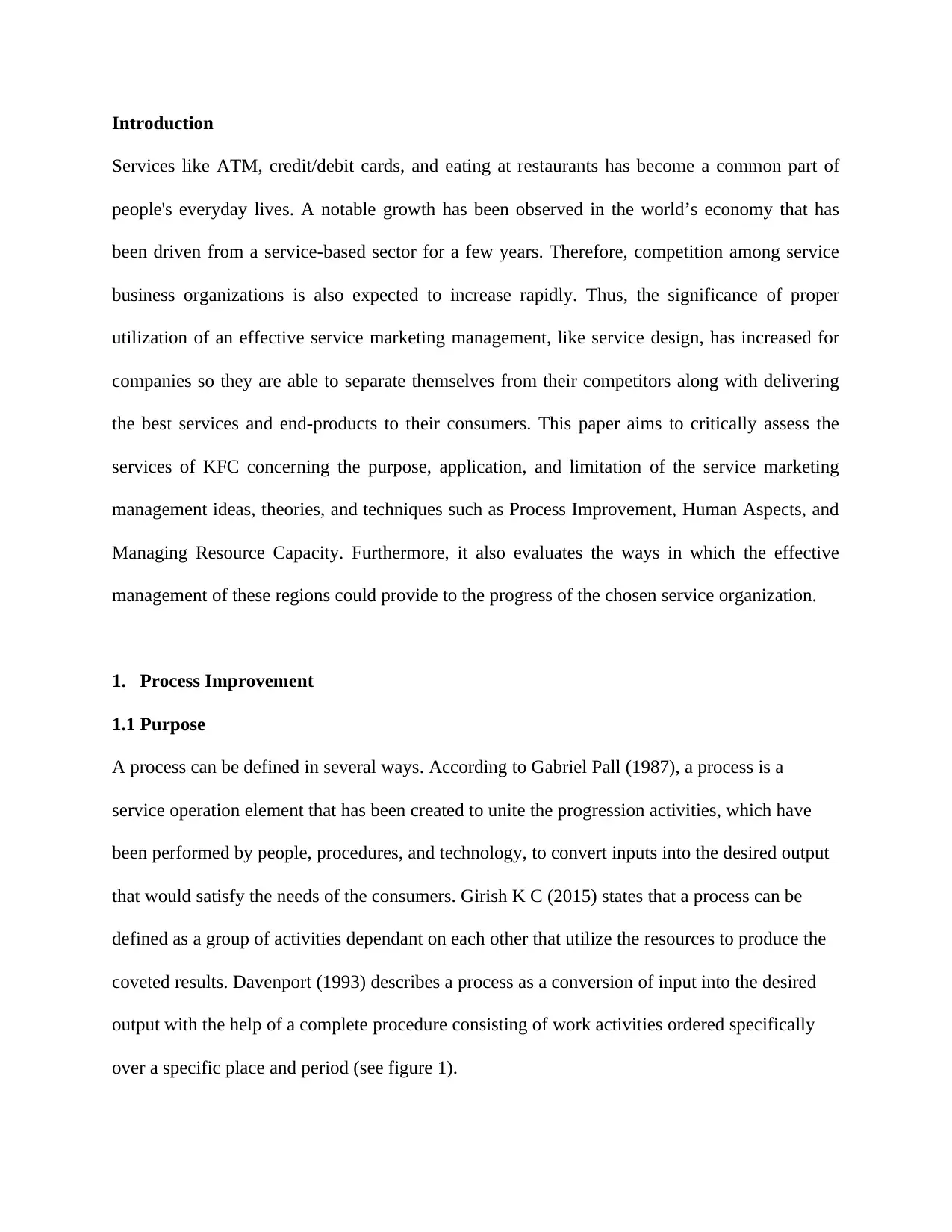
Introduction
Services like ATM, credit/debit cards, and eating at restaurants has become a common part of
people's everyday lives. A notable growth has been observed in the world’s economy that has
been driven from a service-based sector for a few years. Therefore, competition among service
business organizations is also expected to increase rapidly. Thus, the significance of proper
utilization of an effective service marketing management, like service design, has increased for
companies so they are able to separate themselves from their competitors along with delivering
the best services and end-products to their consumers. This paper aims to critically assess the
services of KFC concerning the purpose, application, and limitation of the service marketing
management ideas, theories, and techniques such as Process Improvement, Human Aspects, and
Managing Resource Capacity. Furthermore, it also evaluates the ways in which the effective
management of these regions could provide to the progress of the chosen service organization.
1. Process Improvement
1.1 Purpose
A process can be defined in several ways. According to Gabriel Pall (1987), a process is a
service operation element that has been created to unite the progression activities, which have
been performed by people, procedures, and technology, to convert inputs into the desired output
that would satisfy the needs of the consumers. Girish K C (2015) states that a process can be
defined as a group of activities dependant on each other that utilize the resources to produce the
coveted results. Davenport (1993) describes a process as a conversion of input into the desired
output with the help of a complete procedure consisting of work activities ordered specifically
over a specific place and period (see figure 1).
Services like ATM, credit/debit cards, and eating at restaurants has become a common part of
people's everyday lives. A notable growth has been observed in the world’s economy that has
been driven from a service-based sector for a few years. Therefore, competition among service
business organizations is also expected to increase rapidly. Thus, the significance of proper
utilization of an effective service marketing management, like service design, has increased for
companies so they are able to separate themselves from their competitors along with delivering
the best services and end-products to their consumers. This paper aims to critically assess the
services of KFC concerning the purpose, application, and limitation of the service marketing
management ideas, theories, and techniques such as Process Improvement, Human Aspects, and
Managing Resource Capacity. Furthermore, it also evaluates the ways in which the effective
management of these regions could provide to the progress of the chosen service organization.
1. Process Improvement
1.1 Purpose
A process can be defined in several ways. According to Gabriel Pall (1987), a process is a
service operation element that has been created to unite the progression activities, which have
been performed by people, procedures, and technology, to convert inputs into the desired output
that would satisfy the needs of the consumers. Girish K C (2015) states that a process can be
defined as a group of activities dependant on each other that utilize the resources to produce the
coveted results. Davenport (1993) describes a process as a conversion of input into the desired
output with the help of a complete procedure consisting of work activities ordered specifically
over a specific place and period (see figure 1).
Paraphrase This Document
Need a fresh take? Get an instant paraphrase of this document with our AI Paraphraser
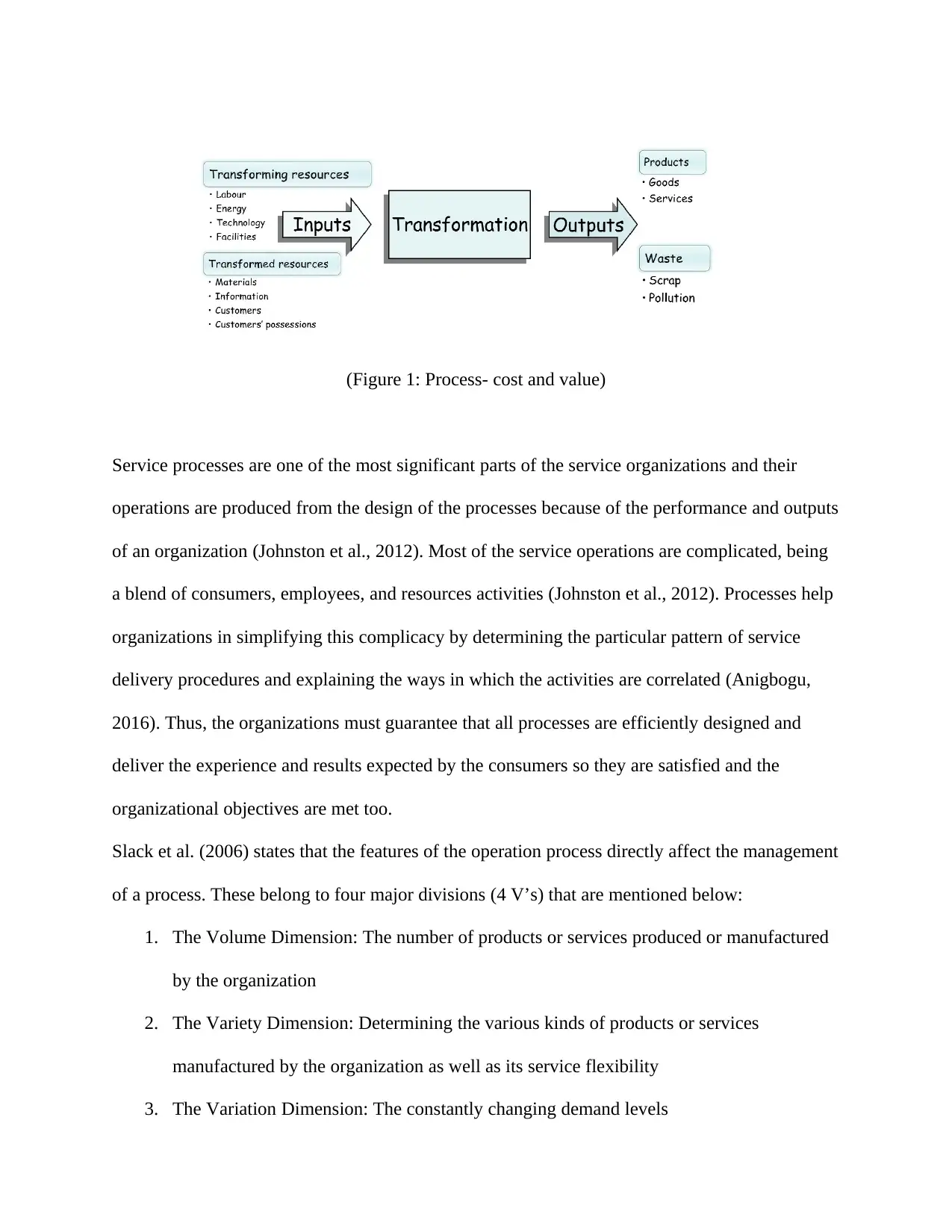
(Figure 1: Process- cost and value)
Service processes are one of the most significant parts of the service organizations and their
operations are produced from the design of the processes because of the performance and outputs
of an organization (Johnston et al., 2012). Most of the service operations are complicated, being
a blend of consumers, employees, and resources activities (Johnston et al., 2012). Processes help
organizations in simplifying this complicacy by determining the particular pattern of service
delivery procedures and explaining the ways in which the activities are correlated (Anigbogu,
2016). Thus, the organizations must guarantee that all processes are efficiently designed and
deliver the experience and results expected by the consumers so they are satisfied and the
organizational objectives are met too.
Slack et al. (2006) states that the features of the operation process directly affect the management
of a process. These belong to four major divisions (4 V’s) that are mentioned below:
1. The Volume Dimension: The number of products or services produced or manufactured
by the organization
2. The Variety Dimension: Determining the various kinds of products or services
manufactured by the organization as well as its service flexibility
3. The Variation Dimension: The constantly changing demand levels
Service processes are one of the most significant parts of the service organizations and their
operations are produced from the design of the processes because of the performance and outputs
of an organization (Johnston et al., 2012). Most of the service operations are complicated, being
a blend of consumers, employees, and resources activities (Johnston et al., 2012). Processes help
organizations in simplifying this complicacy by determining the particular pattern of service
delivery procedures and explaining the ways in which the activities are correlated (Anigbogu,
2016). Thus, the organizations must guarantee that all processes are efficiently designed and
deliver the experience and results expected by the consumers so they are satisfied and the
organizational objectives are met too.
Slack et al. (2006) states that the features of the operation process directly affect the management
of a process. These belong to four major divisions (4 V’s) that are mentioned below:
1. The Volume Dimension: The number of products or services produced or manufactured
by the organization
2. The Variety Dimension: Determining the various kinds of products or services
manufactured by the organization as well as its service flexibility
3. The Variation Dimension: The constantly changing demand levels
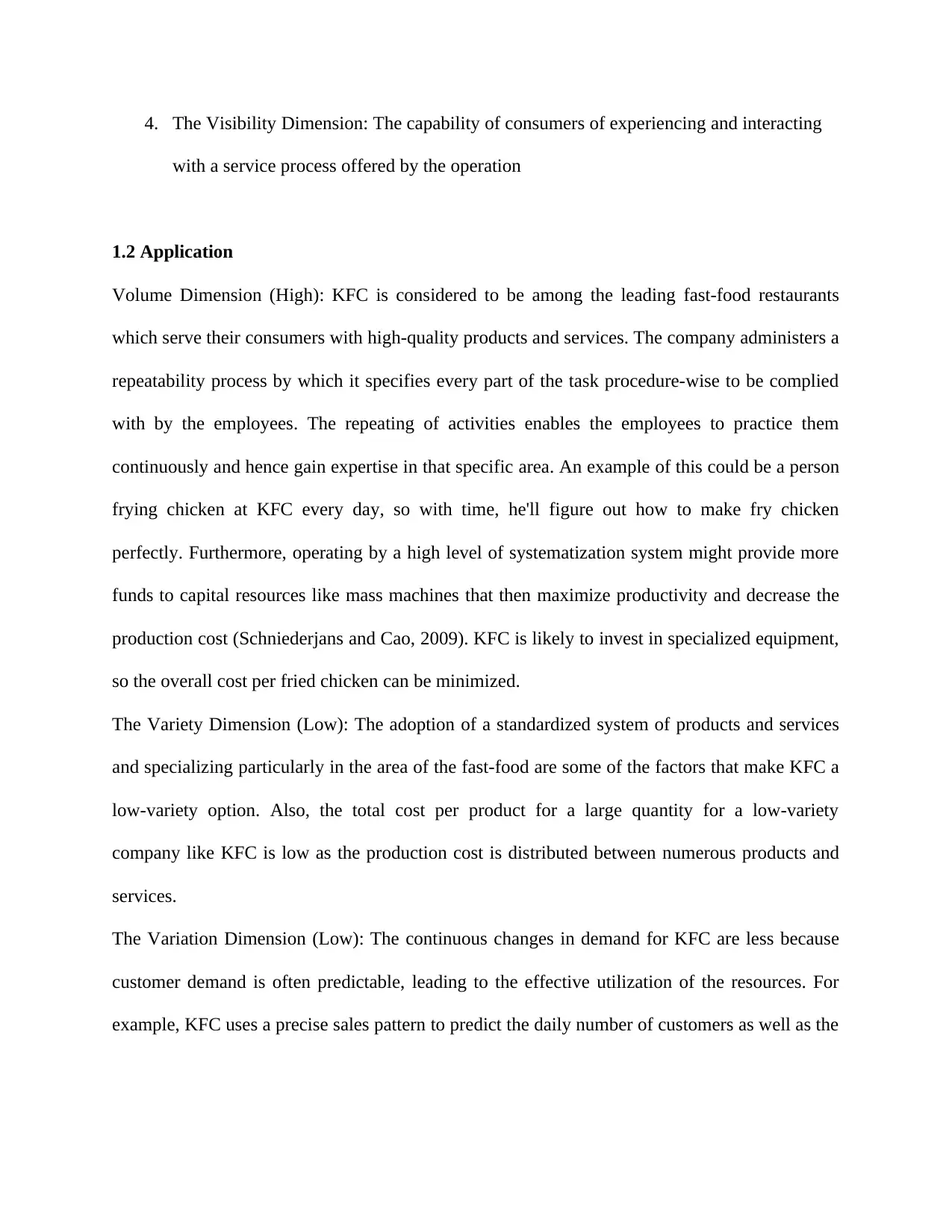
4. The Visibility Dimension: The capability of consumers of experiencing and interacting
with a service process offered by the operation
1.2 Application
Volume Dimension (High): KFC is considered to be among the leading fast-food restaurants
which serve their consumers with high-quality products and services. The company administers a
repeatability process by which it specifies every part of the task procedure-wise to be complied
with by the employees. The repeating of activities enables the employees to practice them
continuously and hence gain expertise in that specific area. An example of this could be a person
frying chicken at KFC every day, so with time, he'll figure out how to make fry chicken
perfectly. Furthermore, operating by a high level of systematization system might provide more
funds to capital resources like mass machines that then maximize productivity and decrease the
production cost (Schniederjans and Cao, 2009). KFC is likely to invest in specialized equipment,
so the overall cost per fried chicken can be minimized.
The Variety Dimension (Low): The adoption of a standardized system of products and services
and specializing particularly in the area of the fast-food are some of the factors that make KFC a
low-variety option. Also, the total cost per product for a large quantity for a low-variety
company like KFC is low as the production cost is distributed between numerous products and
services.
The Variation Dimension (Low): The continuous changes in demand for KFC are less because
customer demand is often predictable, leading to the effective utilization of the resources. For
example, KFC uses a precise sales pattern to predict the daily number of customers as well as the
with a service process offered by the operation
1.2 Application
Volume Dimension (High): KFC is considered to be among the leading fast-food restaurants
which serve their consumers with high-quality products and services. The company administers a
repeatability process by which it specifies every part of the task procedure-wise to be complied
with by the employees. The repeating of activities enables the employees to practice them
continuously and hence gain expertise in that specific area. An example of this could be a person
frying chicken at KFC every day, so with time, he'll figure out how to make fry chicken
perfectly. Furthermore, operating by a high level of systematization system might provide more
funds to capital resources like mass machines that then maximize productivity and decrease the
production cost (Schniederjans and Cao, 2009). KFC is likely to invest in specialized equipment,
so the overall cost per fried chicken can be minimized.
The Variety Dimension (Low): The adoption of a standardized system of products and services
and specializing particularly in the area of the fast-food are some of the factors that make KFC a
low-variety option. Also, the total cost per product for a large quantity for a low-variety
company like KFC is low as the production cost is distributed between numerous products and
services.
The Variation Dimension (Low): The continuous changes in demand for KFC are less because
customer demand is often predictable, leading to the effective utilization of the resources. For
example, KFC uses a precise sales pattern to predict the daily number of customers as well as the
⊘ This is a preview!⊘
Do you want full access?
Subscribe today to unlock all pages.

Trusted by 1+ million students worldwide
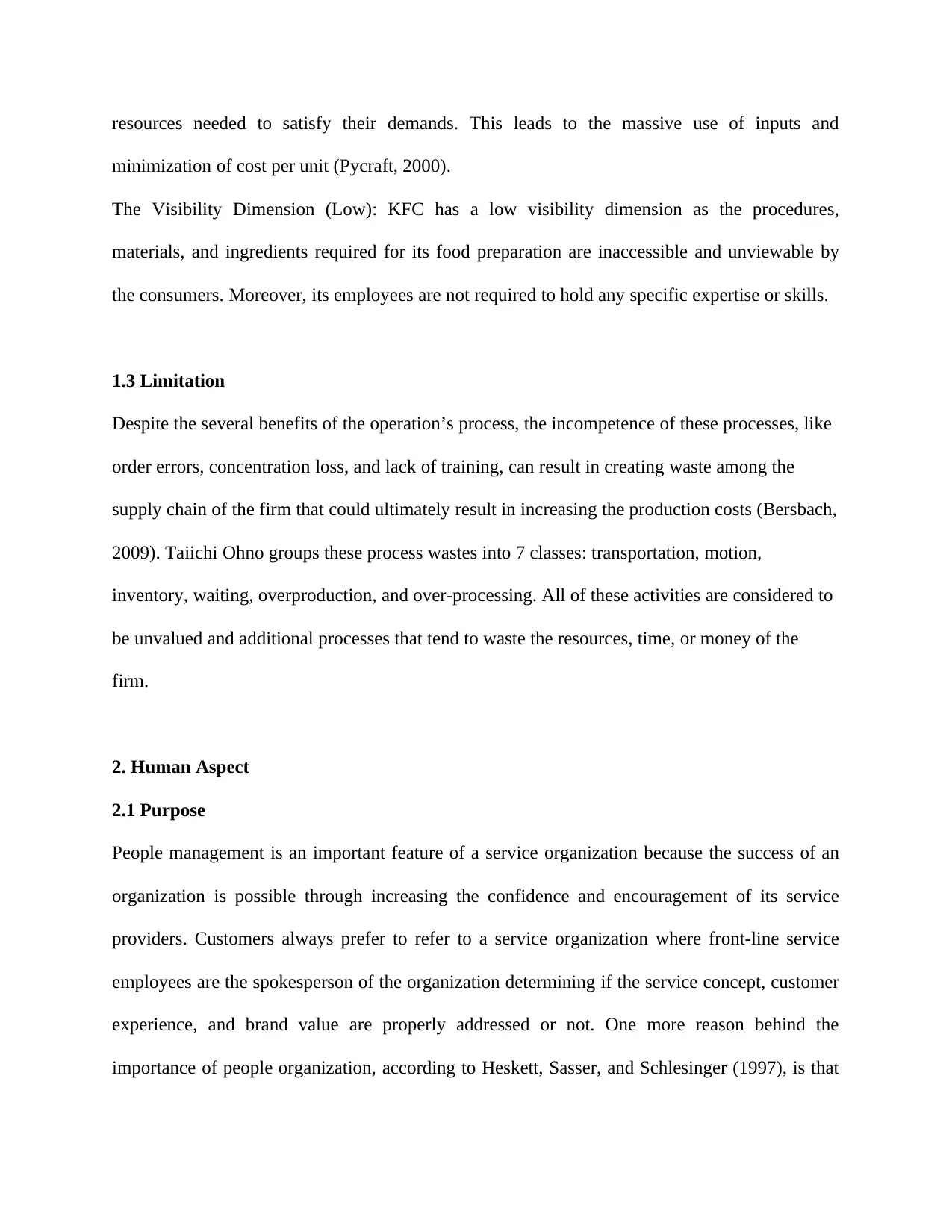
resources needed to satisfy their demands. This leads to the massive use of inputs and
minimization of cost per unit (Pycraft, 2000).
The Visibility Dimension (Low): KFC has a low visibility dimension as the procedures,
materials, and ingredients required for its food preparation are inaccessible and unviewable by
the consumers. Moreover, its employees are not required to hold any specific expertise or skills.
1.3 Limitation
Despite the several benefits of the operation’s process, the incompetence of these processes, like
order errors, concentration loss, and lack of training, can result in creating waste among the
supply chain of the firm that could ultimately result in increasing the production costs (Bersbach,
2009). Taiichi Ohno groups these process wastes into 7 classes: transportation, motion,
inventory, waiting, overproduction, and over-processing. All of these activities are considered to
be unvalued and additional processes that tend to waste the resources, time, or money of the
firm.
2. Human Aspect
2.1 Purpose
People management is an important feature of a service organization because the success of an
organization is possible through increasing the confidence and encouragement of its service
providers. Customers always prefer to refer to a service organization where front-line service
employees are the spokesperson of the organization determining if the service concept, customer
experience, and brand value are properly addressed or not. One more reason behind the
importance of people organization, according to Heskett, Sasser, and Schlesinger (1997), is that
minimization of cost per unit (Pycraft, 2000).
The Visibility Dimension (Low): KFC has a low visibility dimension as the procedures,
materials, and ingredients required for its food preparation are inaccessible and unviewable by
the consumers. Moreover, its employees are not required to hold any specific expertise or skills.
1.3 Limitation
Despite the several benefits of the operation’s process, the incompetence of these processes, like
order errors, concentration loss, and lack of training, can result in creating waste among the
supply chain of the firm that could ultimately result in increasing the production costs (Bersbach,
2009). Taiichi Ohno groups these process wastes into 7 classes: transportation, motion,
inventory, waiting, overproduction, and over-processing. All of these activities are considered to
be unvalued and additional processes that tend to waste the resources, time, or money of the
firm.
2. Human Aspect
2.1 Purpose
People management is an important feature of a service organization because the success of an
organization is possible through increasing the confidence and encouragement of its service
providers. Customers always prefer to refer to a service organization where front-line service
employees are the spokesperson of the organization determining if the service concept, customer
experience, and brand value are properly addressed or not. One more reason behind the
importance of people organization, according to Heskett, Sasser, and Schlesinger (1997), is that
Paraphrase This Document
Need a fresh take? Get an instant paraphrase of this document with our AI Paraphraser
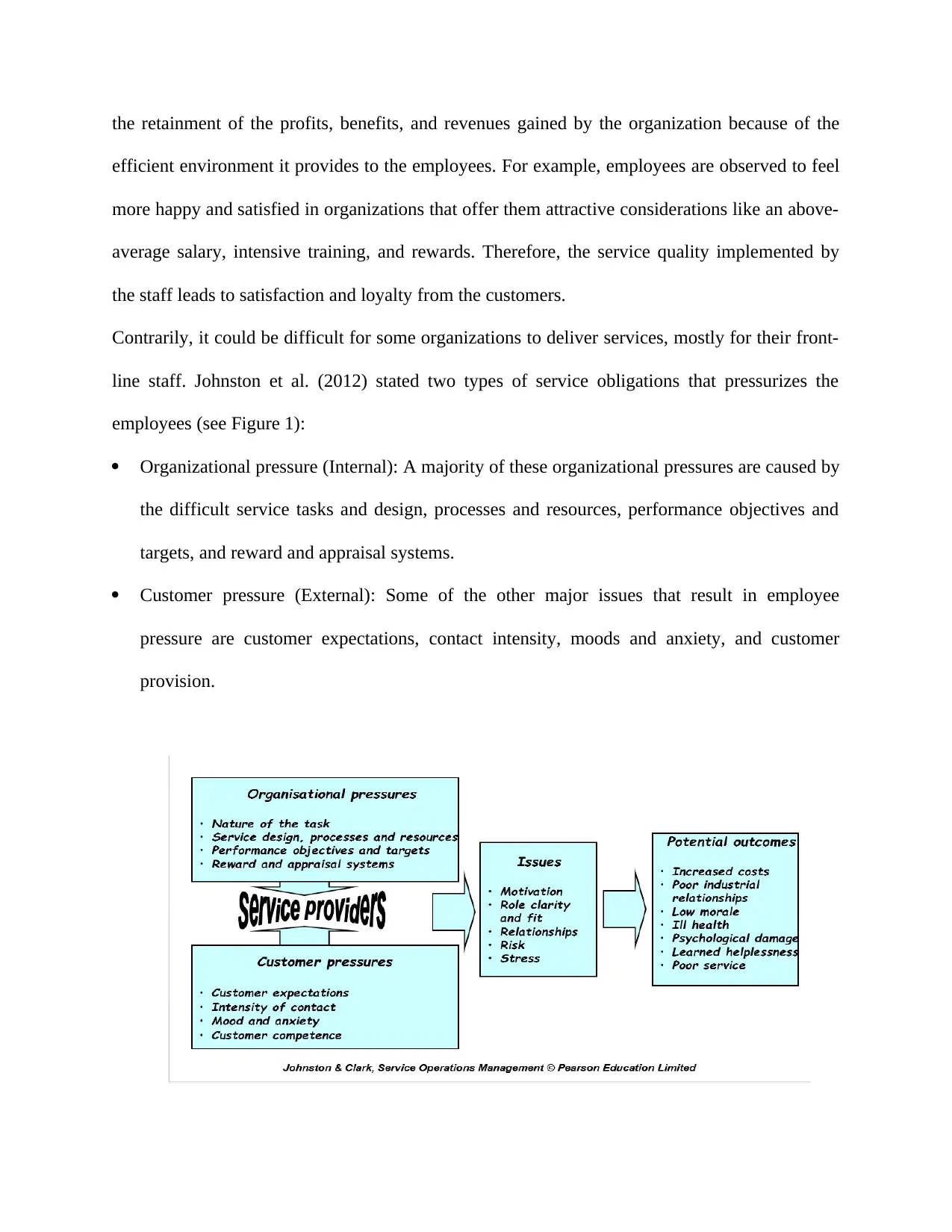
the retainment of the profits, benefits, and revenues gained by the organization because of the
efficient environment it provides to the employees. For example, employees are observed to feel
more happy and satisfied in organizations that offer them attractive considerations like an above-
average salary, intensive training, and rewards. Therefore, the service quality implemented by
the staff leads to satisfaction and loyalty from the customers.
Contrarily, it could be difficult for some organizations to deliver services, mostly for their front-
line staff. Johnston et al. (2012) stated two types of service obligations that pressurizes the
employees (see Figure 1):
Organizational pressure (Internal): A majority of these organizational pressures are caused by
the difficult service tasks and design, processes and resources, performance objectives and
targets, and reward and appraisal systems.
Customer pressure (External): Some of the other major issues that result in employee
pressure are customer expectations, contact intensity, moods and anxiety, and customer
provision.
efficient environment it provides to the employees. For example, employees are observed to feel
more happy and satisfied in organizations that offer them attractive considerations like an above-
average salary, intensive training, and rewards. Therefore, the service quality implemented by
the staff leads to satisfaction and loyalty from the customers.
Contrarily, it could be difficult for some organizations to deliver services, mostly for their front-
line staff. Johnston et al. (2012) stated two types of service obligations that pressurizes the
employees (see Figure 1):
Organizational pressure (Internal): A majority of these organizational pressures are caused by
the difficult service tasks and design, processes and resources, performance objectives and
targets, and reward and appraisal systems.
Customer pressure (External): Some of the other major issues that result in employee
pressure are customer expectations, contact intensity, moods and anxiety, and customer
provision.

(Figure 2: effect of organizational and customer pressure)
Such pressures result in causing problems like stress and demotivation of the employees, leading
to severe issues like illness, increased costs, and weak service (see Figure 2). Thus, organizations
must consider the well-being of their front-line service providers so they are effectively able to
satisfy their consumers as ignorance in this domain could lead to harmful impacts on operation
costs and sale revenues.
2.2 Application
KFC has implemented various strategies for organization management for the effective
management and motivation of the employees so they are able to handle the issues occurring due
to the customer and organizational pressure and for the improvement of their work environment.
The Human Resource Vice president KFC UK, James Watts, considers training and development
to be an essential approach for the company due to their effectiveness in developing the business
as well as providing huge opportunities to the employees for enhancing their personal,
leadership, and life skills that would help them in deciding the right career for themselves (Kfc-
csr.co.uk, 2018). KFC gives massive amounts of money and time to implement training and
education programs for its employees. Some of these programs include KFC degrees,
Apprenticeships, and programs by Yum! University. Moreover, the firm launched a new learning
method in 2011 that accommodated advance technology for a training and development program
named as the “Learning Zone”. This system aims to ease access for employees and allow them to
interact with the training modules, along with communicating and collaborating over various
divisions (Kfc-csr.co.uk, 2018). The study also reveals that employees deliver better productivity
Such pressures result in causing problems like stress and demotivation of the employees, leading
to severe issues like illness, increased costs, and weak service (see Figure 2). Thus, organizations
must consider the well-being of their front-line service providers so they are effectively able to
satisfy their consumers as ignorance in this domain could lead to harmful impacts on operation
costs and sale revenues.
2.2 Application
KFC has implemented various strategies for organization management for the effective
management and motivation of the employees so they are able to handle the issues occurring due
to the customer and organizational pressure and for the improvement of their work environment.
The Human Resource Vice president KFC UK, James Watts, considers training and development
to be an essential approach for the company due to their effectiveness in developing the business
as well as providing huge opportunities to the employees for enhancing their personal,
leadership, and life skills that would help them in deciding the right career for themselves (Kfc-
csr.co.uk, 2018). KFC gives massive amounts of money and time to implement training and
education programs for its employees. Some of these programs include KFC degrees,
Apprenticeships, and programs by Yum! University. Moreover, the firm launched a new learning
method in 2011 that accommodated advance technology for a training and development program
named as the “Learning Zone”. This system aims to ease access for employees and allow them to
interact with the training modules, along with communicating and collaborating over various
divisions (Kfc-csr.co.uk, 2018). The study also reveals that employees deliver better productivity
⊘ This is a preview!⊘
Do you want full access?
Subscribe today to unlock all pages.

Trusted by 1+ million students worldwide

and commitment to the organization if they consider the work to be useful and important (Bloisi,
2007). KFC concerns making its employees feel appreciated through proposals of attractive
incentives like bonuses and rewards given by various programs for their effective
retainment (Jones, 2018).
Therefore, a well-designed process and system result in motivating, protecting, and reducing the
pressure of the employees. Thus, the front-line employees feel empowered and involved within
the organization and are able to offer better services and easily deal with both the internal and
external limitations, leading to the improvement of the overall business.
2.3 Limitation
Weak job designs and systems can result in causing numerous harms to organizations and their
employees. Research conducted by the bond (2006) shows that poor job control and social
support negatively influence the physical and mental health of employees through their
defection, psychological anguish, job disapproval, and illnesses. Thus, the employees would end
up in needing more time and resources to be to trained and to understand the system, which will
result in higher costs yet lower productivity (Graves, 1992)
3. Managing resources capacity
3.1 Purpose
The effective utilization of the resources available to an organization is one of the most essential
duties of the management so it can provide the best and affordable services to its consumers.
Johnston et al. (2012) described capacity as the largest number of value-added activities that a
service process can obtain over some time under regular working circumstances. Thus, a
2007). KFC concerns making its employees feel appreciated through proposals of attractive
incentives like bonuses and rewards given by various programs for their effective
retainment (Jones, 2018).
Therefore, a well-designed process and system result in motivating, protecting, and reducing the
pressure of the employees. Thus, the front-line employees feel empowered and involved within
the organization and are able to offer better services and easily deal with both the internal and
external limitations, leading to the improvement of the overall business.
2.3 Limitation
Weak job designs and systems can result in causing numerous harms to organizations and their
employees. Research conducted by the bond (2006) shows that poor job control and social
support negatively influence the physical and mental health of employees through their
defection, psychological anguish, job disapproval, and illnesses. Thus, the employees would end
up in needing more time and resources to be to trained and to understand the system, which will
result in higher costs yet lower productivity (Graves, 1992)
3. Managing resources capacity
3.1 Purpose
The effective utilization of the resources available to an organization is one of the most essential
duties of the management so it can provide the best and affordable services to its consumers.
Johnston et al. (2012) described capacity as the largest number of value-added activities that a
service process can obtain over some time under regular working circumstances. Thus, a
Paraphrase This Document
Need a fresh take? Get an instant paraphrase of this document with our AI Paraphraser
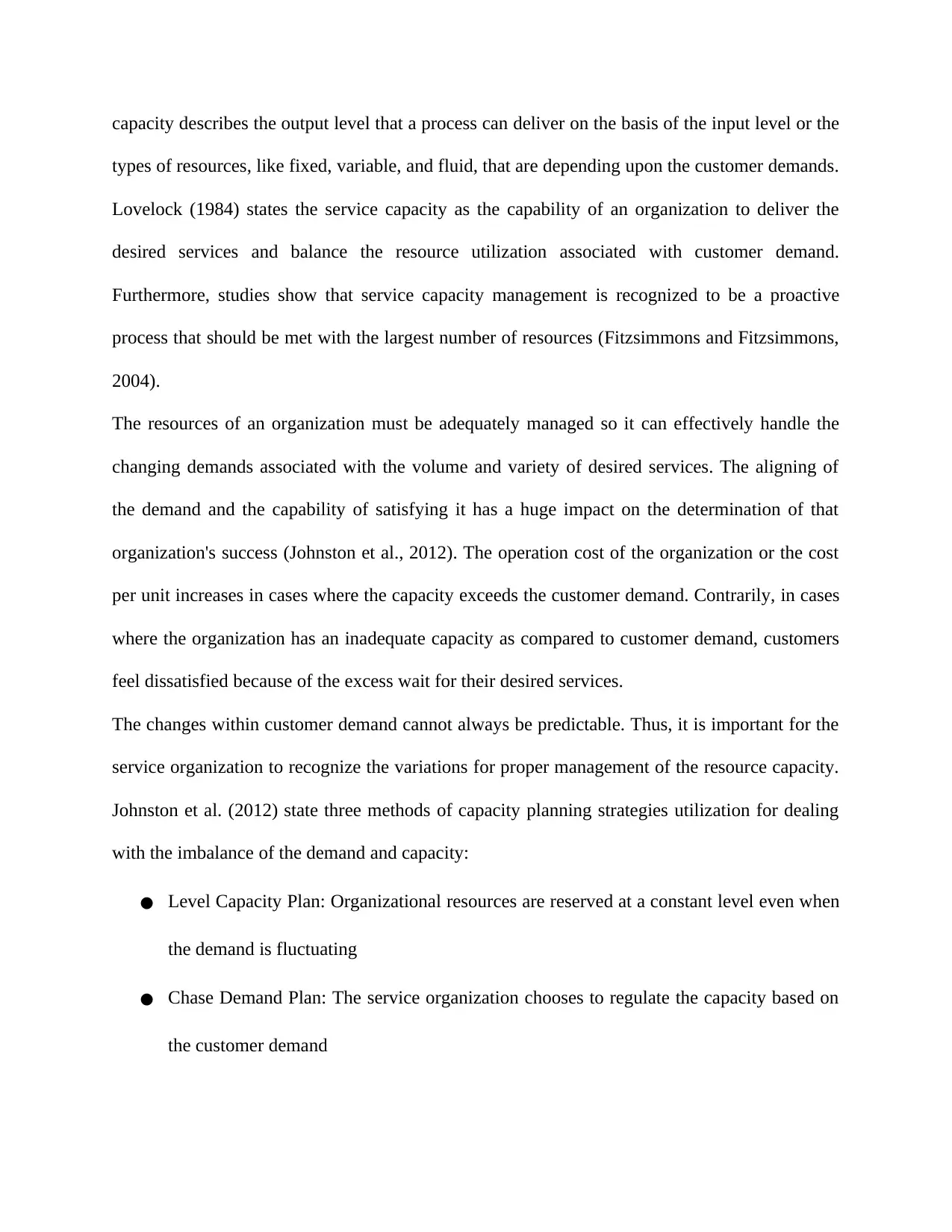
capacity describes the output level that a process can deliver on the basis of the input level or the
types of resources, like fixed, variable, and fluid, that are depending upon the customer demands.
Lovelock (1984) states the service capacity as the capability of an organization to deliver the
desired services and balance the resource utilization associated with customer demand.
Furthermore, studies show that service capacity management is recognized to be a proactive
process that should be met with the largest number of resources (Fitzsimmons and Fitzsimmons,
2004).
The resources of an organization must be adequately managed so it can effectively handle the
changing demands associated with the volume and variety of desired services. The aligning of
the demand and the capability of satisfying it has a huge impact on the determination of that
organization's success (Johnston et al., 2012). The operation cost of the organization or the cost
per unit increases in cases where the capacity exceeds the customer demand. Contrarily, in cases
where the organization has an inadequate capacity as compared to customer demand, customers
feel dissatisfied because of the excess wait for their desired services.
The changes within customer demand cannot always be predictable. Thus, it is important for the
service organization to recognize the variations for proper management of the resource capacity.
Johnston et al. (2012) state three methods of capacity planning strategies utilization for dealing
with the imbalance of the demand and capacity:
● Level Capacity Plan: Organizational resources are reserved at a constant level even when
the demand is fluctuating
● Chase Demand Plan: The service organization chooses to regulate the capacity based on
the customer demand
types of resources, like fixed, variable, and fluid, that are depending upon the customer demands.
Lovelock (1984) states the service capacity as the capability of an organization to deliver the
desired services and balance the resource utilization associated with customer demand.
Furthermore, studies show that service capacity management is recognized to be a proactive
process that should be met with the largest number of resources (Fitzsimmons and Fitzsimmons,
2004).
The resources of an organization must be adequately managed so it can effectively handle the
changing demands associated with the volume and variety of desired services. The aligning of
the demand and the capability of satisfying it has a huge impact on the determination of that
organization's success (Johnston et al., 2012). The operation cost of the organization or the cost
per unit increases in cases where the capacity exceeds the customer demand. Contrarily, in cases
where the organization has an inadequate capacity as compared to customer demand, customers
feel dissatisfied because of the excess wait for their desired services.
The changes within customer demand cannot always be predictable. Thus, it is important for the
service organization to recognize the variations for proper management of the resource capacity.
Johnston et al. (2012) state three methods of capacity planning strategies utilization for dealing
with the imbalance of the demand and capacity:
● Level Capacity Plan: Organizational resources are reserved at a constant level even when
the demand is fluctuating
● Chase Demand Plan: The service organization chooses to regulate the capacity based on
the customer demand
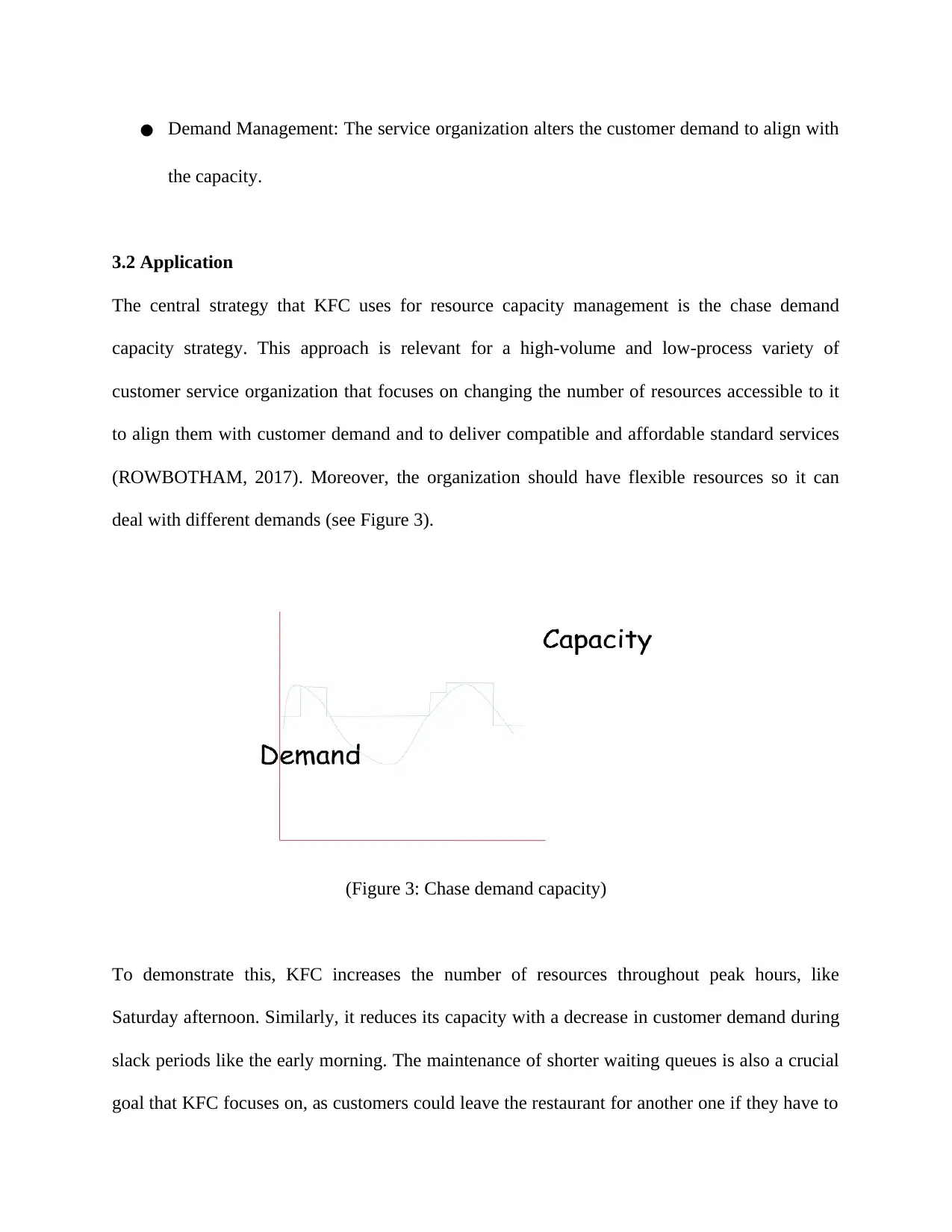
● Demand Management: The service organization alters the customer demand to align with
the capacity.
3.2 Application
The central strategy that KFC uses for resource capacity management is the chase demand
capacity strategy. This approach is relevant for a high-volume and low-process variety of
customer service organization that focuses on changing the number of resources accessible to it
to align them with customer demand and to deliver compatible and affordable standard services
(ROWBOTHAM, 2017). Moreover, the organization should have flexible resources so it can
deal with different demands (see Figure 3).
(Figure 3: Chase demand capacity)
To demonstrate this, KFC increases the number of resources throughout peak hours, like
Saturday afternoon. Similarly, it reduces its capacity with a decrease in customer demand during
slack periods like the early morning. The maintenance of shorter waiting queues is also a crucial
goal that KFC focuses on, as customers could leave the restaurant for another one if they have to
the capacity.
3.2 Application
The central strategy that KFC uses for resource capacity management is the chase demand
capacity strategy. This approach is relevant for a high-volume and low-process variety of
customer service organization that focuses on changing the number of resources accessible to it
to align them with customer demand and to deliver compatible and affordable standard services
(ROWBOTHAM, 2017). Moreover, the organization should have flexible resources so it can
deal with different demands (see Figure 3).
(Figure 3: Chase demand capacity)
To demonstrate this, KFC increases the number of resources throughout peak hours, like
Saturday afternoon. Similarly, it reduces its capacity with a decrease in customer demand during
slack periods like the early morning. The maintenance of shorter waiting queues is also a crucial
goal that KFC focuses on, as customers could leave the restaurant for another one if they have to
⊘ This is a preview!⊘
Do you want full access?
Subscribe today to unlock all pages.

Trusted by 1+ million students worldwide

wait too long for their desired service (Johnston et al., 2012). KFC adopts numerous strategies
for the control of capacity level. Some of these are mentioned below:
Flexible staffing levels: KFC offers flexibility in the employee working hours by
providing the option of various shift patterns and durations (Kfc-csr.co.uk, 2018). The
restaurant manager is responsible for deciding the shifts and schedules for its employees.
For example, the main shift team could be working during the entire operational period of
the restaurant, yet the organization gives additional capacity with the help of part-time
staff to be able to meet the high demand during the peak hours. This allows them to gain
several advantages like the reduction of the extra service operation costs associated with
overtime and unused resources (ROWBOTHAM, 2017).
Make use of customers: During the peak hours, KFC encourages its customers to discard
the waste and the tray from their table themselves.
3.3 Limitation
The service organization could find it difficult to deal with the imbalance between service
capacity and customer demand. Because of this, the restaurant could enter the “coping zone” in
which the managers and employees have to face massive pressure and stress while working
(Johnston et al., 2012). Therefore, employees end up treating the customers with unsuitable
behavior delivering inadequate capacity to them, leading to the creation of an overall negative
image of the restaurant's service (Armistead and Clark, 1994).
Conclusion
for the control of capacity level. Some of these are mentioned below:
Flexible staffing levels: KFC offers flexibility in the employee working hours by
providing the option of various shift patterns and durations (Kfc-csr.co.uk, 2018). The
restaurant manager is responsible for deciding the shifts and schedules for its employees.
For example, the main shift team could be working during the entire operational period of
the restaurant, yet the organization gives additional capacity with the help of part-time
staff to be able to meet the high demand during the peak hours. This allows them to gain
several advantages like the reduction of the extra service operation costs associated with
overtime and unused resources (ROWBOTHAM, 2017).
Make use of customers: During the peak hours, KFC encourages its customers to discard
the waste and the tray from their table themselves.
3.3 Limitation
The service organization could find it difficult to deal with the imbalance between service
capacity and customer demand. Because of this, the restaurant could enter the “coping zone” in
which the managers and employees have to face massive pressure and stress while working
(Johnston et al., 2012). Therefore, employees end up treating the customers with unsuitable
behavior delivering inadequate capacity to them, leading to the creation of an overall negative
image of the restaurant's service (Armistead and Clark, 1994).
Conclusion
Paraphrase This Document
Need a fresh take? Get an instant paraphrase of this document with our AI Paraphraser
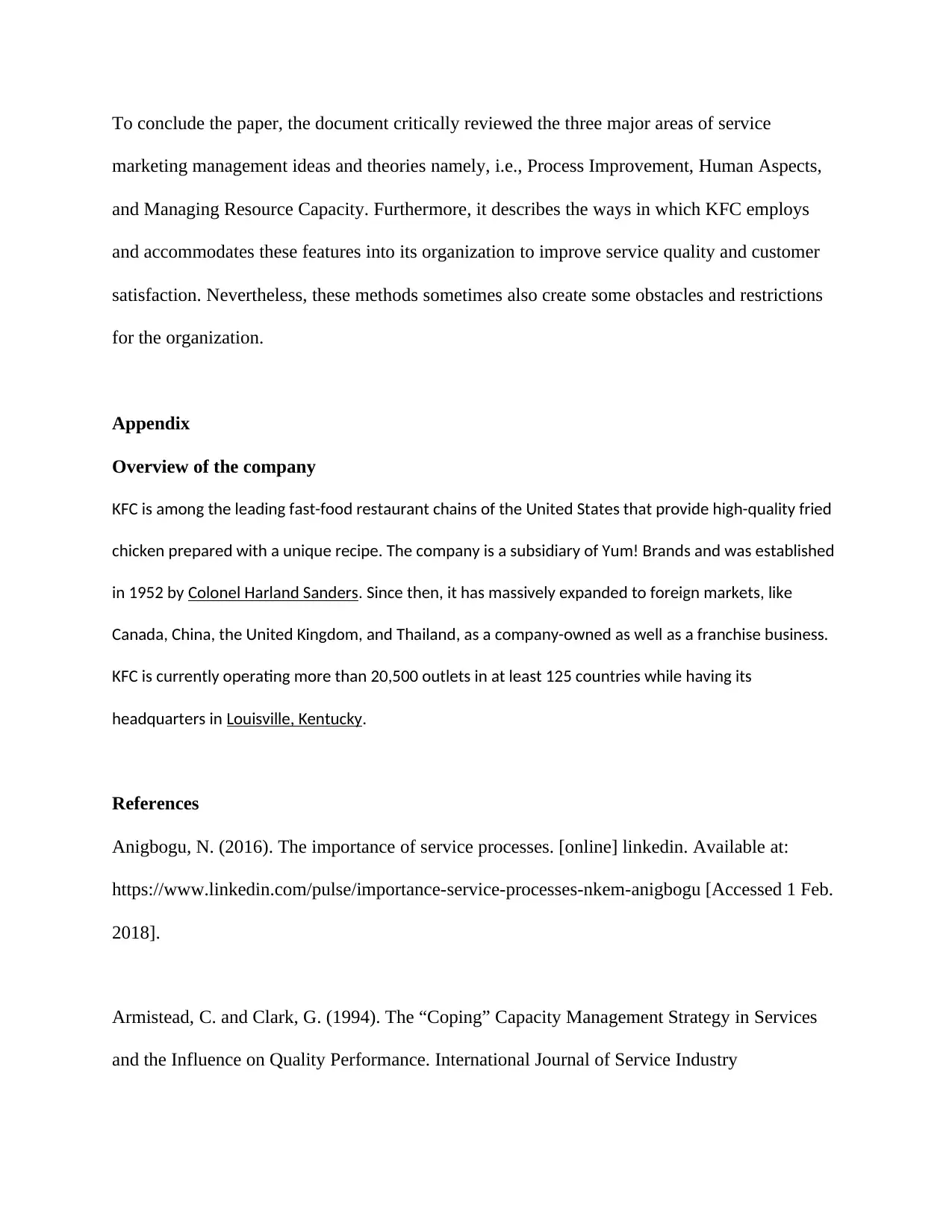
To conclude the paper, the document critically reviewed the three major areas of service
marketing management ideas and theories namely, i.e., Process Improvement, Human Aspects,
and Managing Resource Capacity. Furthermore, it describes the ways in which KFC employs
and accommodates these features into its organization to improve service quality and customer
satisfaction. Nevertheless, these methods sometimes also create some obstacles and restrictions
for the organization.
Appendix
Overview of the company
KFC is among the leading fast-food restaurant chains of the United States that provide high-quality fried
chicken prepared with a unique recipe. The company is a subsidiary of Yum! Brands and was established
in 1952 by Colonel Harland Sanders. Since then, it has massively expanded to foreign markets, like
Canada, China, the United Kingdom, and Thailand, as a company-owned as well as a franchise business.
KFC is currently operating more than 20,500 outlets in at least 125 countries while having its
headquarters in Louisville, Kentucky.
References
Anigbogu, N. (2016). The importance of service processes. [online] linkedin. Available at:
https://www.linkedin.com/pulse/importance-service-processes-nkem-anigbogu [Accessed 1 Feb.
2018].
Armistead, C. and Clark, G. (1994). The “Coping” Capacity Management Strategy in Services
and the Influence on Quality Performance. International Journal of Service Industry
marketing management ideas and theories namely, i.e., Process Improvement, Human Aspects,
and Managing Resource Capacity. Furthermore, it describes the ways in which KFC employs
and accommodates these features into its organization to improve service quality and customer
satisfaction. Nevertheless, these methods sometimes also create some obstacles and restrictions
for the organization.
Appendix
Overview of the company
KFC is among the leading fast-food restaurant chains of the United States that provide high-quality fried
chicken prepared with a unique recipe. The company is a subsidiary of Yum! Brands and was established
in 1952 by Colonel Harland Sanders. Since then, it has massively expanded to foreign markets, like
Canada, China, the United Kingdom, and Thailand, as a company-owned as well as a franchise business.
KFC is currently operating more than 20,500 outlets in at least 125 countries while having its
headquarters in Louisville, Kentucky.
References
Anigbogu, N. (2016). The importance of service processes. [online] linkedin. Available at:
https://www.linkedin.com/pulse/importance-service-processes-nkem-anigbogu [Accessed 1 Feb.
2018].
Armistead, C. and Clark, G. (1994). The “Coping” Capacity Management Strategy in Services
and the Influence on Quality Performance. International Journal of Service Industry
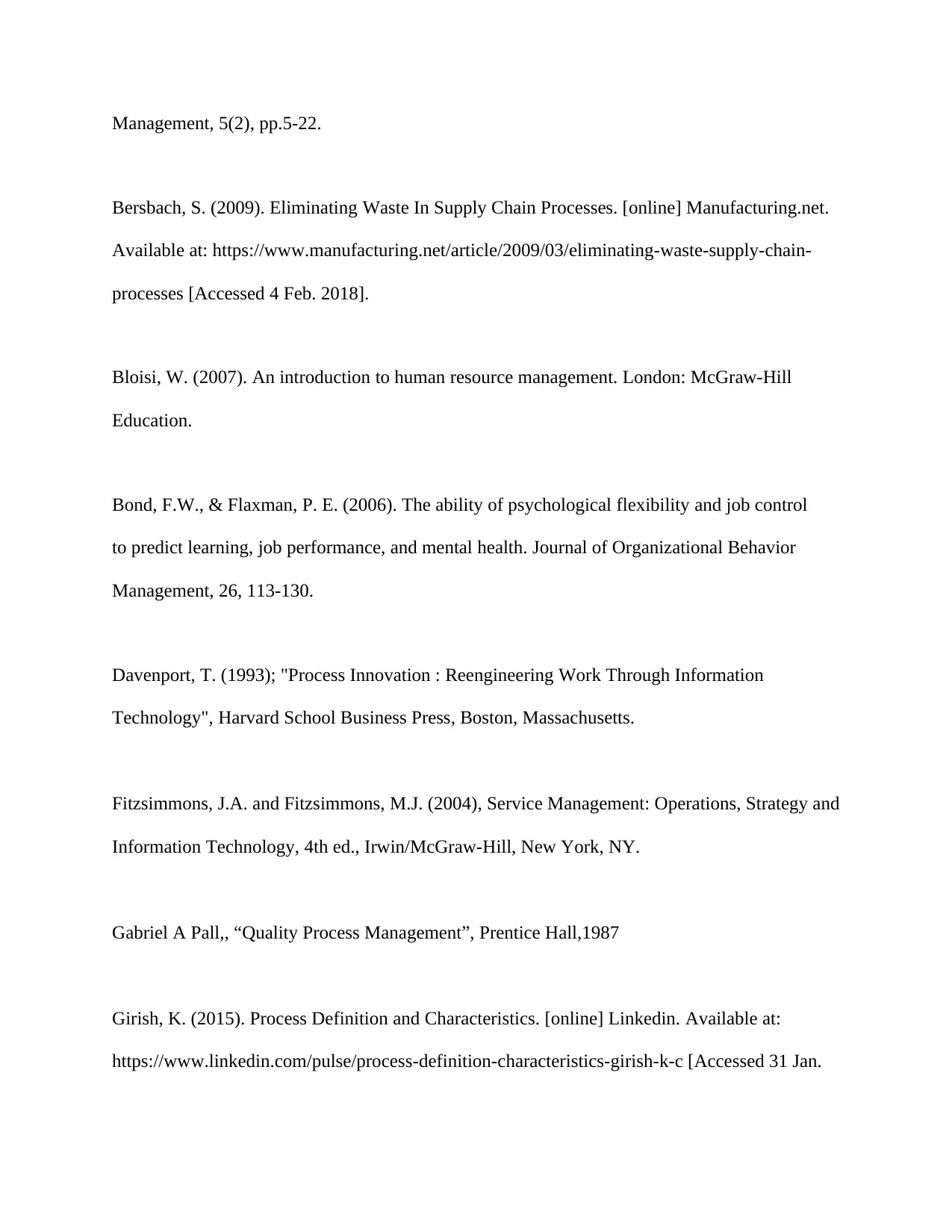
Management, 5(2), pp.5-22.
Bersbach, S. (2009). Eliminating Waste In Supply Chain Processes. [online] Manufacturing.net.
Available at: https://www.manufacturing.net/article/2009/03/eliminating-waste-supply-chain-
processes [Accessed 4 Feb. 2018].
Bloisi, W. (2007). An introduction to human resource management. London: McGraw-Hill
Education.
Bond, F.W., & Flaxman, P. E. (2006). The ability of psychological flexibility and job control
to predict learning, job performance, and mental health. Journal of Organizational Behavior
Management, 26, 113-130.
Davenport, T. (1993); "Process Innovation : Reengineering Work Through Information
Technology", Harvard School Business Press, Boston, Massachusetts.
Fitzsimmons, J.A. and Fitzsimmons, M.J. (2004), Service Management: Operations, Strategy and
Information Technology, 4th ed., Irwin/McGraw-Hill, New York, NY.
Gabriel A Pall,, “Quality Process Management”, Prentice Hall,1987
Girish, K. (2015). Process Definition and Characteristics. [online] Linkedin. Available at:
https://www.linkedin.com/pulse/process-definition-characteristics-girish-k-c [Accessed 31 Jan.
Bersbach, S. (2009). Eliminating Waste In Supply Chain Processes. [online] Manufacturing.net.
Available at: https://www.manufacturing.net/article/2009/03/eliminating-waste-supply-chain-
processes [Accessed 4 Feb. 2018].
Bloisi, W. (2007). An introduction to human resource management. London: McGraw-Hill
Education.
Bond, F.W., & Flaxman, P. E. (2006). The ability of psychological flexibility and job control
to predict learning, job performance, and mental health. Journal of Organizational Behavior
Management, 26, 113-130.
Davenport, T. (1993); "Process Innovation : Reengineering Work Through Information
Technology", Harvard School Business Press, Boston, Massachusetts.
Fitzsimmons, J.A. and Fitzsimmons, M.J. (2004), Service Management: Operations, Strategy and
Information Technology, 4th ed., Irwin/McGraw-Hill, New York, NY.
Gabriel A Pall,, “Quality Process Management”, Prentice Hall,1987
Girish, K. (2015). Process Definition and Characteristics. [online] Linkedin. Available at:
https://www.linkedin.com/pulse/process-definition-characteristics-girish-k-c [Accessed 31 Jan.
⊘ This is a preview!⊘
Do you want full access?
Subscribe today to unlock all pages.

Trusted by 1+ million students worldwide
1 out of 14
Related Documents
Your All-in-One AI-Powered Toolkit for Academic Success.
+13062052269
info@desklib.com
Available 24*7 on WhatsApp / Email
![[object Object]](/_next/static/media/star-bottom.7253800d.svg)
Unlock your academic potential
Copyright © 2020–2025 A2Z Services. All Rights Reserved. Developed and managed by ZUCOL.





